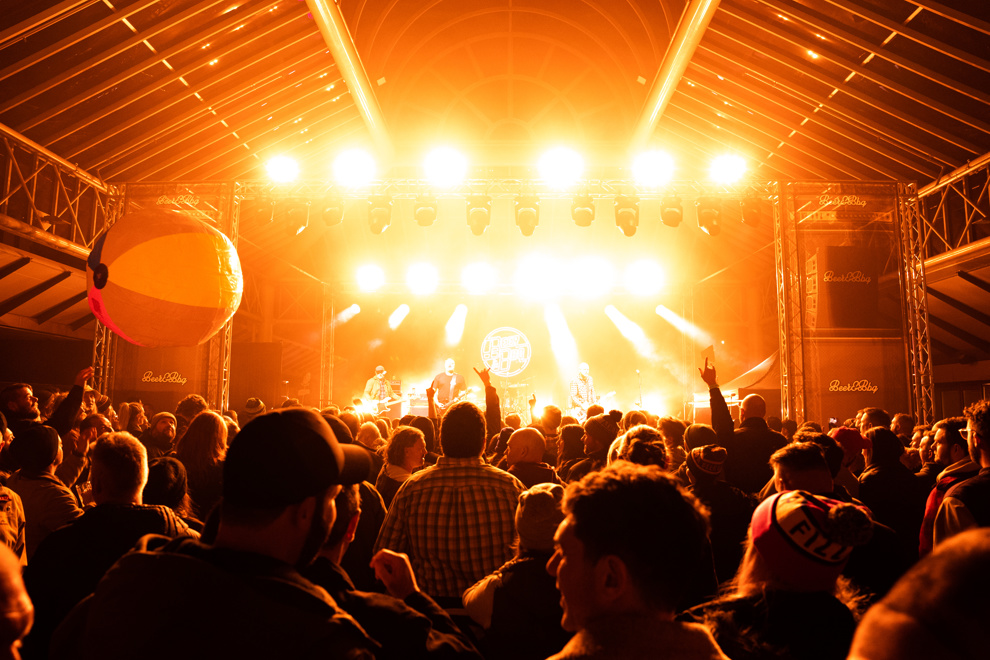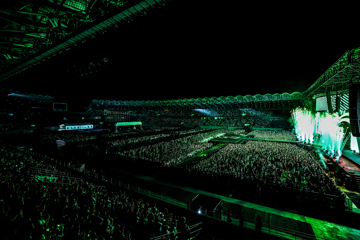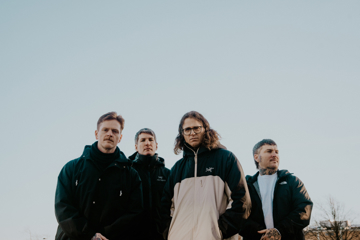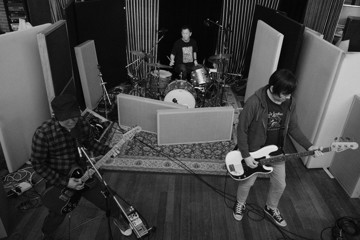Major Music Festivals Continue Trend As Economic Boosters
Dark Mofo and RISING are among the 2025 events that have returned reinvigorated, following the trend of Laneway, Bluesfest, and other Australian festivals.

Adelaide Beer & BBQ Festival (Credit: Nick Astanei)
After a strong May, major Australian music festivals in the first weeks of June continue to attract large crowds and inject millions of dollars into their local economies.
The retro Cooly Rocks On in Coolangatta, Queensland, topped 160,000 over five days (June 4 to 8) of Elvis contestants, 900 classic muscle cars, and music and fashions from the 1950s, 1960s and 1970s.
This year, the festival is expected to boost the Gold Coast economy by $20 million. Its revenue jumped from $9 million in 2019 to $18 million in 2023. As the festival expands, there will be more events and incentives for patrons to spend more.
Promoter Mark Duckworth told the Gold Coast Bulletin that attendees from around Australia spend 6.5 nights while those from abroad – mostly from the United States, New Zealand and Japan – stay an average of 8.6 nights.
“Cooly Rocks On just keeps on growing,” he said. “The festival brings so much more than nostalgia to Coolangatta, it also brings a huge economic boost to the city with an influx of visitors from not only interstate but internationally too.”
On the King’s Birthday Long Weekend, the 10th and final Adelaide Beer & BBQ Festival (ABBF) drew 20,000 to the Showground to catch a dozen DJs and 40 live acts.
Don't miss a beat with our FREE daily newsletter
These included Wolfmother, The Chats and Tim Finn, while Henry Wagons debuted his new show CASH: The American Recordings.
No specific economic numbers were available immediately, but 60 brewers poured more than 65,000 beers to down tonnes of brisket, pork, burgers, wings and Philly cheesesteaks.
One of them, Brett Doonan, of South Coast Brewing and Chubby Unicorn, stressed how the event had helped build local traders.
“It has helped our business grow, learn and meet people in our industry we wouldn’t have had the chance to; From sharing ideas, collaborations, talking about the highs and lows, it’s been amazing.”
Since launching in 2015, ABBF hosted over 175,000 punters and supported more than 400 local businesses. Festival founders Gareth Lewis and Aaron Sandow agreed the format had run its course, and would unveil its new model and location over the next couple of months.
Invigorating
Dark Mofo (June 5 to 15) returns after a year’s hiatus with one of its best and invigorating programs paying off.
After first day sales of 40,000 – interstate fans making up 70 per cent of buyers – the figure rose to 50,000 by the time gates opened, with organisers confident it will easily hit 100,000 by the time it ends this year’s run.
The Mofo debut by new Artistic Director Chris Twite included 17 Aussie music exclusives, including darkwave Boy Harsher and Cold Cave, car crashes, collective screams and artists buried in sand joining Mofo staples such as the instantly sold-out Night Mass, the June 21 Nude Solstice Swim and Winter Feast.
RISING in Melbourne, which is hosting 610 local and international artists at 100 events between June 4 to 15, looks like it could be heading to break last year’s attendance.
In 2024, it added an extra 45,000 patrons to reach 680,000, surpassing its box office target by selling 70,031 tickets, with 55 per cent of shows sold out.
Aside from employment for musicians and artists, it adds an extra 250 in event management, front of house, technical support & crew, and ticketing.
Major music highlights include indie label Bad Apples Music’s free, all-ages First Nations-led concert at the new Anzac Rail Station, an underwater sound experience at the City Baths (an instant sell-out), and a massive free communal music-making event with electronic music duo SHOUSE called Communitas.
Intangible #form at Capitol Theatre created an artwork of light and lasers, and Blockbuster at Fed Square was a day-long celebration of Pakistani music, Punjabi art, and food.
Gen Z Factor
There may be many reasons for this embracing of festivals, but one is that Australian Gen Zers are increasingly spending cash on live music and are markedly becoming more engaged with music, sports, performance art, comedy, family events, and exhibitions.
According to Ticketek’s FanDX report earlier this year, which reported that the Australian summer had the highest ticket sales – two million – in over a decade, the 18-24 age group attending events increased by 48 per cent. Many were attending festivals like Laneway for the first time, pushing it towards its highest-ever crowds this year.
The interesting stat from Ticketek’s report was that Gen Zers were willing to pay the most for tickets, at an average of $256, followed by Gen X at $244 and Millennials at $238. They are not immune to cost-of-living pressures, but are more willing to take on multiple jobs or pay in instalments for the thrill of being there.
This trend is essential. It means that this age group is the least price-conscious in Australia, even as it starts to dominate festival crowds.
This might be because, as US research firm Luminate suggested, Gen Zers are more comfortable with rising prices as the new norm than other age groups.
But Luminate also noted that Gen Z in Europe are more likely than its US cousins to fork out for expensive tickets. This might be, it suggested, because festivals in that part of the world tend to run longer and with more acts, and are regarded as of greater value.
American Gen Z’s passion for new live experiences is not as high as it is in Australia and Europe. Luminate reported: “The current level of festival prices may already be hitting the limit for prospective attendees.”
Luminate’s Q1 report, released this week, also highlighted the trend from the past 12 months where US Gen Z females are increasingly making their presence felt.
They are more likely to attend concerts than males compared to those in other age groups, and 10 per cent more likely to attend a live music event in the next 12 months.
Autumn Tone
Autumn’s festivals had already set the positive tone, starting with 109,000 for Bluesfest Byron Bay (its third highest of all time since 1990), 80,000 for Perth Festival’s East Perth Power Station venue, 353,556 for Adelaide Festival and 13,000 for Tasmania’s Party In The Paddock.
Final figures are still being worked out for Blues On Broadbeach on the Gold Coast (May 15 to 18) with headliners Jimmy Barnes and Eric Gale. But promoter Mark Duckworth senses it’s looking like edging past last year’s 160,000.
It also seems certain to have pumped $24 million into the Gold Coast economy, up from $20 million in 2024.
Daniel Eagles from music venue Den Divine commented: “I think it’s been the best festival yet. We are a night venue and we are chockers through the day, which is amazing.
“To have the foot traffic coming through Broadbeach is absolutely incredible, it has never been this busy.”
The Northern Territory’s 30-act BASSINTHEGRASS in Darwin (May 17) – headlined by Hilltop Hoods – had 11,000 at Mindil Beach. NT Minister for Major Events Marie-Clare Boothby revealed 25 per cent of the crowd was from outside the Territory.
This year’s economic boost was not revealed. But in 2021, the event generated $14.5 million for the NT economy, $12 million of it new money.
The Minister added: “Events such as BASSINTHEGRASS are not only a celebration of music and community, they’re also a major boost for our economy, local businesses, and tourism.
The First Nations’ 10th Parrtjima – A Festival in Light in Alice Springs reached a new attendance high of 23,500.
It is expected to match its $12.22 million boost to the Northern Territory economy, including $9.42 million flowing directly into Alice Springs. One third of the crowd journeyed from across the borders, and 70 per cent of these travel to Alice Springs just for Parrtjima.
In Queensland, Festival of Outback Skies in Hughenden had its best turnout yet with over 3,000 while the three day Carnivale in Port Douglas got 10,000.
As reported by The Music, 15,000 packing into Barnard Park, Busselton for triple j's One Night Stand (May 24) was a boon for associations. Proceeds from the $15 tickets led to $57,000 donated to Support Act, while others benefiting were youth charity The Push, Undalup Association and Karri Karrak Aboriginal Corporation.
Support Act’s Clive Miller revealed, “Since July 2023, we’ve provided $167,000 in crisis relief to 61 music workers across Western Australia.
“Each grant [is] a lifeline for someone navigating illness, injury or personal hardship.”







